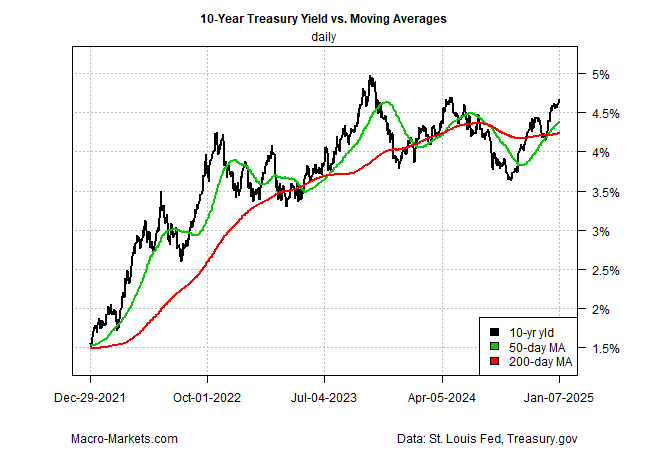The risk of reflation has been bubbling for several months and yesterday’s economic news on prices in the services sector fueled new concerns. The bond market is paying attention, or so the renewed rise in the US 10-year Treasury yield suggests.
The benchmark 10-year rate jumped to 4.67% on Tuesday (Jan. 7), according to Treasury.gov. The rise lifted the yield to its highest level in over eight months. Meanwhile, the policy-sensitive 2-year yield ticked up to 4.30%, near its highest level since August. As a result, the 2-year rate is essentially trading in line with the current Fed funds target rate, which is pegged at a 4.25%-to-4.50% range. This is the first time in nearly two years that the 2-year yield hasn’t traded below the Fed funds target rate.
Clearly, the Treasury market is trying to send a message. For some perspective on what that might be, let’s review a few charts, starting with the 10-year yield. The key takeaway: it’s been clear for several months that the benchmark rate has been trending higher. The recent increase in the 50-day average above its 200-day average suggests that recent runup will persist.

As for the 2-year yield, this maturity is widely followed as a proxy for summarizing the market’s expectations for Fed policy. On that basis, the market is no longer pricing in rate cuts as the 2-year rate trades in line with the target rate.

For a clearer view of how the 2-year yield has fared relative to the Fed funds rate, the next chart below highlights the conspicuous change in recent days in the relationship.

What’s driving the change? Growing concerns that sticky inflation will persist, perhaps leading to a period of reflation. As discussed on CapitalSpectator.com in recent weeks, the risk of a revival in pricing pressure has been topical. Yesterday’s economic news fueled that concern via the strength in the December ISM services price index — marking the highest reading since Jan. 2024.
Concerns about the possibility of firmer inflation risk is partly related to various policy changes planned by the incoming Trump administration is part of the mix. Overall, “You’re getting a recalibration of inflation expectations and Fed rate expectations,” says Tom Hainlin, senior investment strategist at US Bank Asset Management Group.
There’s still room for debate about where inflation is headed and whether current Fed policy is appropriate to deal with the potential for stronger pricing pressure. Meantime, rate cuts are probably off the table for the near term, and the possibility of rate hikes may be brewing. The central bank will likely focus on incoming data with a sharper eye for deciding if reflation risk is a blip or the start of the bigger shift. Meantime, the Treasury market is demanding a higher risk premium in yield to cover any fallout if the Fed has bungled into a policy error by cutting rates too early in recent months.
